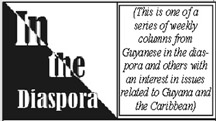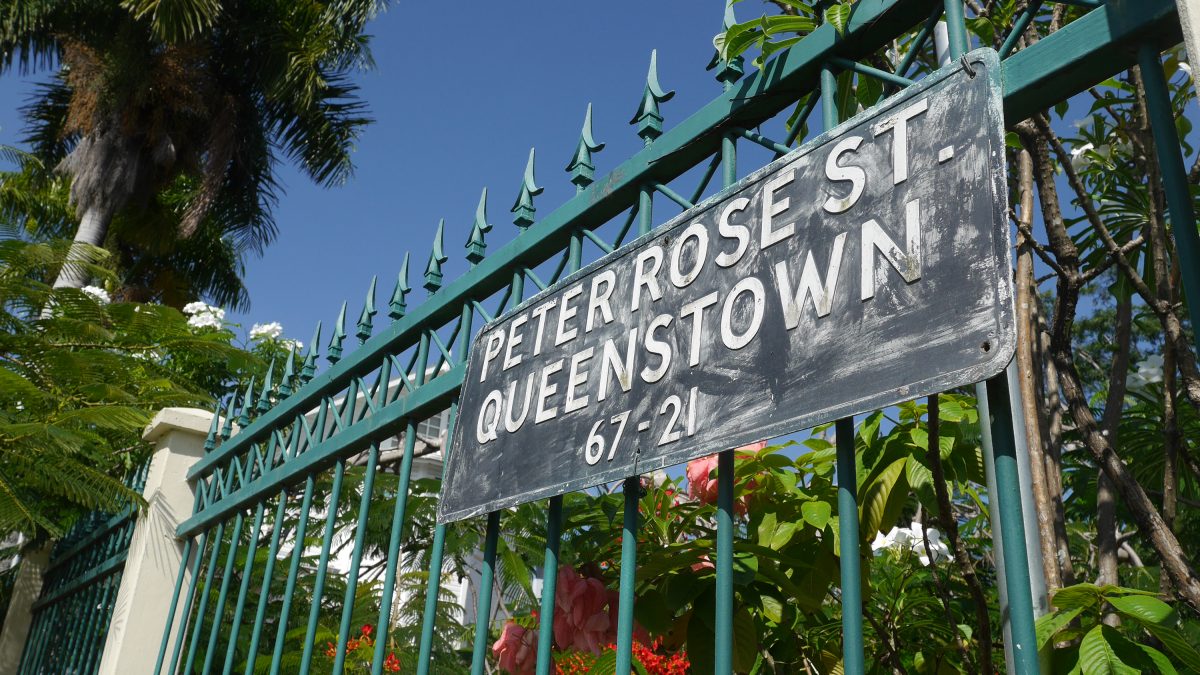By Thomas Harding
Thomas Harding is writing a book about the 1823 Demerara rebellion. To find out more about his previous books go to his website www.thomasharding.com or you can email him at 1823@thomasharding.com
 Since my last article for this newspaper, in which I confessed how much I wanted to visit Guyana, but wasn’t able to because of the Covid pandemic, I have managed to find a way through.
Since my last article for this newspaper, in which I confessed how much I wanted to visit Guyana, but wasn’t able to because of the Covid pandemic, I have managed to find a way through.
Thanks to the support of the Guyana Civil Aviation Authority, Eastern Airlines and two trips to the doctor to prove I am Covid negative, I arrived last Tuesday safe and sound in Georgetown.
As I waited in line at immigration control in Cheddi Jagan International Airport, I looked at my passport and thought about my name ‘Thomas Harding’. Really, it’s a fake name.
When my grandparents arrived in London in 1936 after fleeing Nazi Germany (they were Jewish), their passports stated their names to be ‘Eric and Elsie Hirschowitz’. A few days later, and after getting some nasty reactions from their new neighbours, they decided to adopt a more English sounding moniker, one they thought would help them fit in.
So my grandfather opened the telephone directory, looked up names starting with ‘H’ and seeing ‘Harding’ thought to himself ‘that one looks okay to me.’ Hence my last name.
Names carry stories. And stories carry history. Which carries meaning.
To my great fortune, I am staying at the Herdmanston Lodge, that wondrous oasis in Queenstown. I have been introduced to cook-up, fried salt fish, bake, barbeque chicken, Roti with curry, soup with obstacles, Tulsie and Tinsel tea and, most excitingly of all, pepper pot, culinary delights I had previously been told about them by my Guyanese friends back in London.
During the early evenings, I have enjoyed listening to the macaws and parakeets chirp loudly from the trees. I’m loving the Banks beer and have sipped my first dram (or maybe two) of Eldorado 15.
I am so happy to be here. But for now, before I can venture out, I must sit out the government mandated 7-day isolation.
Soon, though, I will be able to leave the hotel. I am greatly looking forward to visiting the key sites associated with the 1823 Demerara Insurrection: Success, Le Ressouvenir and Mon Repos. Bethel Chapel at B.V. and John Smith church. Camp Street prison (where the rebels were held), the High Court (the site of Colony House where the trials took place), Camp House near the seawall (where Governor Murray lived), and the old parade ground (where many of the rebels were executed).
I have tried to make the most of my time in isolation. I have spent many hours speaking on the phone to those who have studied and written about Guyana’s history, politics and culture, including Winston McGowan, Nigel Westmaas, Sister Pinder, Jenny Daley, Denis Chabrol, Hazel Woolford, and many others. I have learned an enormous amount and look forward to many more conversations in the coming days.
I am also greatly honoured to be taking part in a webinar on 13th October about the 1823 Insurrection convened by the Guyana Institute of Historic Research, where I will join other speakers, including Elton McRae, David Hinds and Dwayne Benjamin.
Today, though, I walked into a question. Actually, I almost did, as my way was blocked by the large double gates that bar the exit from the Herdmanston Lodge through which, whilst I am in isolation, I must not pass.
On the other side of the wrought-iron barrier runs Peter Rose Street, a well-known avenue whose inhabitants include the Ethnic Relations Commission, the Demerara Cricket Club and the Brazilian Embassy. The Guyanese poet Martin Carter lived around the corner.
Wondering about the heritage of the Peter Rose name I looked it up online. Apparently, he was born in Scotland in 1787, arrived in Georgetown in 1801 and was a member of the local government then known as the ‘Court of Policy’. In 1823, this same Court of Policy voted not to outlaw the whipping of enslaved women on the plantations, as had been specifically ordered by the British government in London.
Wanting to find out more, I plugged his name into the Legacies of Slave-Owners database – a remarkable project run by the University College London which, since 2013, has made available the names of British slave-owners. Sure enough, there was the name of Peter Rose.
According to the database, Peter Rose (and it is highly likely that this is the same man the street is named after) was registered as being the ‘owner’ of hundreds of enslaved people. On the Lima plantation, for instance, he jointly ‘owned’ 494 people, of whom 268 were men and 226 women.
In 1834, after the abolition of slavery, the British government compensated more than 46,000 slave-owners for their losses. Amongst them was Peter Rose. For the 494 enslaved people on the Lima plantation he received more than £13,000. In today’s money that means he received more than US$1.5 million. Of course, the enslaved men and women received nothing.
When I told Keith Williams, the General Manager of the Herdmanston Lodge, about Peter Rose’s back story, he indicated that this was the first time he had learned that the hotel was located on a street named after a slave-owner. ‘I find the disclosure by Mr Harding as deserving of more than passing interest,’ he said, ‘and I invite Guyanese academia to research and validate his assertions. If these assertions are validated, then name change is a strong consideration to reverse the travesty of history in much the same way as Murray Street was changed to Quamina Street in 1985.’
Which made me wonder about the other joint-owner of Lima plantation.
Again, through the Legacies of Slave-Owners database that was easy to find. Turns out the ‘co-owner’ was a man called John Croal. And, sure enough, he also has a street named after him in Georgetown.
Croal Street is a major thoroughfare running from the Botanical Gardens all the way to Stabroek Market on the Demerara River. According to the National Trust of Guyana website, it had previously been known as ‘Red Dam’ as it was covered with red dust.
So who was John Croal? He is known for being the first mayor of Georgetown and he can be linked to several publicly-minded acts. But what else?
Of course, I now knew that he was a slave-owner, and like Peter Rose, received more than USD $1.5 million compensation in today’s money from the British government for losing his ‘ownership’ of enslaved people after abolition. But there’s more.
From my research into the 1823 Demerara Insurrection, I was familiar with the name John Croal. During the rebellion, John Croal was a captain in the British militia and played a leading role in the Battle of Bachelors Adventure, where more than 200 enslaved rebels were killed.
Perhaps even more shockingly, in the days after the rebellion was quashed, Croal and his British comrades mounted a suppression campaign and — without proper trials or judicial process — shot between 100 and 200 innocent men and women.
To return to Keith Williams’ point, what can be done about Peter Rose and Croal streets?
The changing of street names and memorials can be a difficult and controversial matter. Around the world right now, and following the murder of George Floyd, a heated conversation is taking place about just this subject.
In the USA, Black Lives Matter is now the name of a Plaza in Washington DC, while various statues to confederate generals have been removed. A city council in Ontario, Canada is considering changing the name of ‘Plantation Road’. Meanwhile in the UK, we saw the toppling of the statue in Bristol to the slaver Edward Colston, which was dragged through the streets and dumped in the harbour.
So, who were some other participants of the 1823 Demerara Insurrection whose names are sometimes forgotten?
According to the court transcripts from the trials of those who led the 1823 insurrection, Amba was an enslaved woman belonging to Enterprise plantation who took part in the rebellion. At one point, she was described as having a ‘musket on her shoulder’. Amba was later placed in the town prison. There are few recorded instances of women taking part in slave rebellions — even though they likely did. Finding a way to remember them, including and perhaps especially when it is possible to track them in archives, is therefore important.
And of course there is also Jack Gladstone, whom historians now universally accept as the leader of the 1823 Demerara Insurrection (rather than his father Quamina). As it happens, the slave-owning militiaman John Croal testified against Jack at his trial in September 1823.
Jack’s last name is also noteworthy. It was given to Jack because he grew up in the Success plantation, owned by John Gladstone, the British slave-owner and father of the future prime minister of England — William Ewart Gladstone.
Indeed, what’s in a name?






